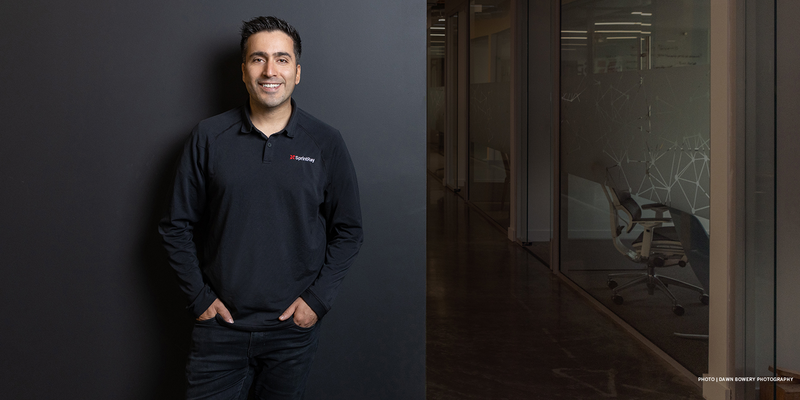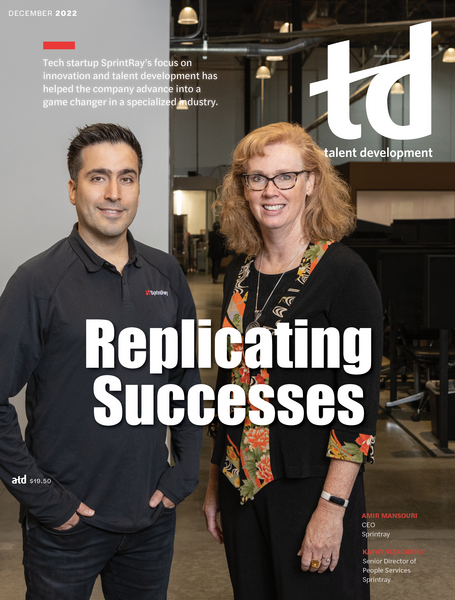TD Magazine Article
Replicating Successes
Tech startup SprintRay’s focus on innovation and talent development has helped the company advance into a game changer in a specialized industry.
Thu Dec 01 2022

Tech startup SprintRay's focus on innovation and talent development has helped the company advance into a game changer in a specialized industry.
Picture this: A team of engineers launches a startup focused on building 3D printers. Customers use the printers to create a variety of items, including tchotchkes of Marvel and Star Wars characters. But then a customer mentions how beneficial 3D printers could be to the dental industry, sparking an idea for the company to focus exclusively on that profession—printing dental parts. No more Yodas.
Less than a decade later—and after a steep learning curve—the startup is considered the leading supplier of 3D printers in dentistry, enabling dental professionals to quickly and easily create dental appliances (such as crowns, clear aligners, and mouth guards) on demand in their offices.
That's the story of SprintRay, a technology company founded in 2014 in Los Angeles, California, and led by Cofounder and CEO Amir Mansouri. During the past two years alone, the company has grown exponentially, from 90 employees in 2020 to more than 600 this year. SprintRay's reach has likewise expanded, with offices now in the US, Canada, Europe, and Asia.
Mansouri credits the company's people services team for building intentional organizational and learning cultures amid SprintRay's rapid growth. He recognizes that sales and expansion aren't the only hallmarks of a successful company—it also takes a healthy workplace environment that fosters innovation, learning, and development.
We met with Mansouri to discuss his experience with starting a company and what it takes to maintain success both in customers' and employees' eyes.
SprintRay is disrupting dentistry. How is your ability to learn and adapt supporting you on that journey?
For us, learning about dentistry was learning something completely different. And sometimes I say dentistry found us; we did not find dentistry. It was one random customer who bought one of our products, and they thought, "This is good for dentistry." And when we looked at it, it made perfect sense.
I have an engineering background, and the other partners and founders were all engineers. We knew nothing about dentistry, so we had to start from scratch. We had to learn all the ins and outs of the technical part of dentistry and how it works.
Our journey is a journey of learning, but it did not start in dentistry.
How did you talk to your partners about readjusting and adapting to dentistry even though that wasn't the original plan?
Change is not easy, especially to engineers. But what really resonated with everyone was that if we hit the ball out of the park with dentistry; if we make good dental parts; enable doctors to do better dentistry; and provide more affordable, accessible dentistry—that really inspired our board, our employees, our investors, and our community. That sense of purpose for being in the dental industry has been the strongest of all. It's helped us to stay motivated.
As in any other learning journey, as you get a little bit of traction, you gain a lot of confidence. It's very rewarding when you start from scratch and don't know anything about it, then you spend a lot of time learning, and you start seeing results. That really inspired and motivated us further.
In what other ways have learning and talent development been principal to SprintRay's success?
We're big on learning and growing talent. When you grow talent, teach them, give them the environment to grow, they give back results. It's encouraging. We have many good stories of our interns joining fresh out of college, and now they're owning departments, owning teams of five to 15 people, three to four years into the job.
When I sit with new engineers, new team members, interns, I tell all of them the same thing: I was at an intern level when I started the company, so you can do it; you can grow it.
Think of it as an ecosystem. It's like growing plants. It's not just the water; it's not the soil—it's the combination of water, right seeds, right soil, temperature, moisture, sun. You need to create that ecosystem. And then with good, fertile soil, everything essentially comes up and blooms and grows.
I learned that it's hard to motivate people, but it's easy to create an environment where people get inspired and motivated. That has been our approach.
I read in one of \[former GE Chairman and CEO\] Jack Welch's books that you can't offer employment for life, but you can offer your team employability for life. We use that as a philosophy. If we can teach our people how to be great leaders, how to be great engineers, if we can coach and grow them—they can go get a job anywhere and be proud of it.
Yes, we might lose some when companies hire from us because we have the best salespeople, best marketing people, or best engineers. But a learning culture attracts more talent, and it helps us grow. That was the guiding principle to create training programs.
Also, we have several certified coaches on the team. And for some leaders who we feel need external help, we'll bring external consultant coaches. If it's a workshop, if it's a coach, we're totally open about bringing those resources to coach and train leaders.
SprintRay has experienced huge employee growth in recent years. How is the company changing as it gets larger and goes global?
It's been challenging. When the company went from 15 to 50 to 500, I felt it. The way I felt it was the culture wasn't the way I wanted. We saw that a couple of departments were pretty much detached—they checked out of the culture and the mission.
That growth was also difficult from the standpoint of training, onboarding people, and the infrastructure to support all these people from the people services standpoint to the training standpoint.
That's when Ed Cohen, our chief people officer, joined. And we got rid of some of the bad accidental culture that had evolved, and we created a more intentional culture.
When they say you grew too fast, that's real. So, we slowed down to beef up a lot of our trainings, processes, and internal infrastructure to be able to support people more and more. You have to constantly evolve to be able to create the right infrastructure and environment to support that many people.
Part of what the people services department has done is develop a people strategy team that is comprised of employees in the US and abroad. What are your expectations of that team, and how do you know that it is delivering on what you're expecting from it?
We created the team in 2020. It's a strategy team, so they're not the doers—they are the ones putting their hand on the pulse to see what's happening in the company, bringing new ideas, looking at the new trends. I measure them by the number of new initiatives they launch annually. For example, last year they rolled out our nine behaviors that everyone in the company participated in developing and suggested adding an expansive career framework, overhauling our parental leave policy, adding a couple of more holidays, and creating more employee appreciation days.
When results from our pulse check surveys are not where we'd like them, this team is the first to help us figure out why and helps give us direction. They help us come up with new programs for learning, new programs for culture, for employee happiness, for managing burnout, for balancing the work-home environment, things like that.
It's a very diverse team. We have representatives from the remote employees, representatives from different departments, from hourly to salary employees, people working in the warehouse, engineers as well as gender and cultural diversity. There are no executives, vice presidents, or directors in that group except the chairperson. We wanted the recommendations to come from the bottom up. It has been very successful.
It appears that anyone in the organization can be an innovator. How do you ensure that their voices are heard and that their ideas are carefully considered?
The real way to do it is to create an environment where people are comfortable coming up with new ideas and new ways of doing things. When you take two, three, four of them seriously, you show everyone that you listened. Everyone basically gets inspired to do it more.
I promote that a lot. I get text and Slack messages from team members saying, "Why don't we do this?" or "Why don't we do that this way?" Sometimes it's hard to say no—for every yes, we have to say 50 nos or not yets. Over the years, we've learned how to say no without demotivating people. You could totally kill innovation by giving a very dry no. It doesn't work, and it really demotivates people.
With regard to the leadership team, how do you select for greatness during the recruitment process?
For a lot of leadership roles, I look for the ability to make decisions. I try not to look at the hard experience. We've been giving a lot of roles to people who did not have prior experience in that specific area but demonstrated good decision making and the ability to move things forward—people with problem-solving skills and creativity in terms of not getting stuck with one way and coming up with other solutions. These are my ways of selecting talent.
Overall, I think we attract the type of people who want to be in a little bit of managed chaos.
How do you personally stay innovative and learn, and how do you share with others what you're learning?
I think staying hungry, like Steve Jobs said. I feel like I always need more knowledge—for example, I may need to sharpen my management skills, my public speaking, or my interview skills. Maybe I had a bad experience; I blew something up. That's when I feel like I have to go learn.
Another part is staying curious. A requirement of innovation is to be curious. Feeding my curiosity has been working a lot for me. Also, having some self-awareness that when I hit a wall on some knowledge and can't carry a conversation on a topic with someone, it's not good, and I have to go learn on that. Those two things have been helping me grow.
Whatever I learn, I'm very passionate about pulling in people who are very close to me in the company. I tell them, "Come check this out. Sit with me, and we'll watch this together." Then we discuss and decide how to spread and use this new knowledge.
How has having a mentor contributed to your leadership and how you run the company?
There are two ways in life: Either you go experience everything or you take a shortcut to people who have been there, done that. Over the years, I've built a good network of former managers, CEOs, and executive technology leaders, and every one of them has different skills. Often, when I have a question or problem, I go to them.
If you stay vulnerable, you put everything on the table and ask for help—people like to help. It's amazing how people will share and help you if you're open to sharing the real problems.
I listen a lot to my advisors. I don't necessarily do 100 percent of what I take in, but I genuinely listen and analyze. And I close the loop with them—I tell them that I didn't do it because of this and that, and they appreciate that at least I gave it the consideration.
I'm a first-time CEO. Had it not been for the mentors who helped me, supported me, and taught me throughout the process, I could not have grown the company up to this point.

